Management and Operations: Leadership Theories at McDonald's Report
VerifiedAdded on 2020/07/23
|15
|5007
|47
Report
AI Summary
This report examines leadership and management practices within McDonald's operations. It begins by differentiating between the roles and characteristics of leaders and managers, illustrating these differences with examples from McDonald's. The report then explores how leadership and management functions are applied in various situations, such as conflict resolution and resource management. It delves into different leadership theories and models, including contingency, situational, and systems leadership, analyzing their strengths and weaknesses. The report also analyzes the importance of operations management, factors influencing operational decision-making, and how leaders and managers can improve operational efficiencies within McDonald's. Finally, it provides a critical evaluation of the application of operations management within the company, drawing on the theories and examples discussed throughout the report. The report concludes with a summary of key findings and insights into effective leadership and management in the context of a global fast-food chain.
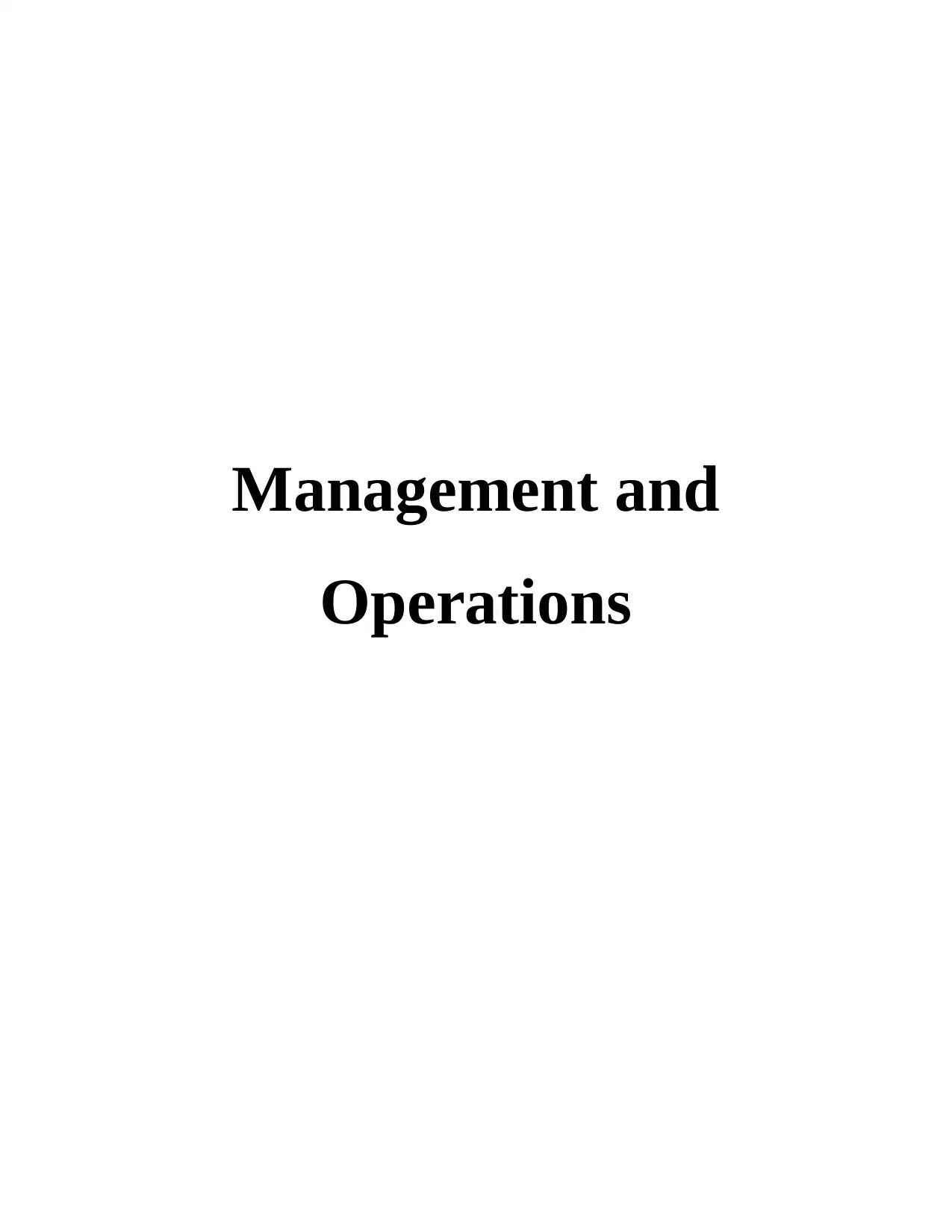
Management and
Operations
Operations
Paraphrase This Document
Need a fresh take? Get an instant paraphrase of this document with our AI Paraphraser
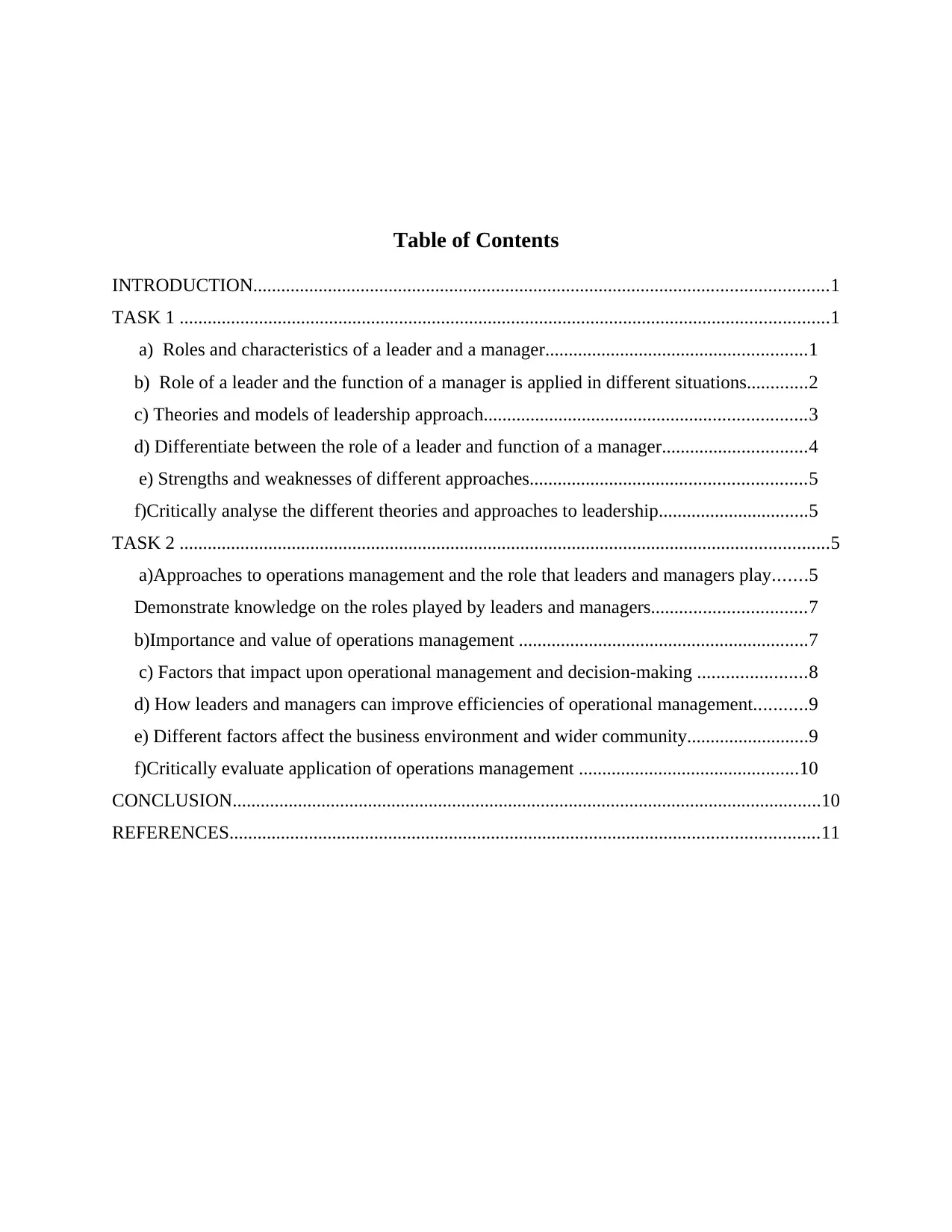
Table of Contents
INTRODUCTION...........................................................................................................................1
TASK 1 ...........................................................................................................................................1
a) Roles and characteristics of a leader and a manager........................................................1
b) Role of a leader and the function of a manager is applied in different situations.............2
c) Theories and models of leadership approach.....................................................................3
d) Differentiate between the role of a leader and function of a manager...............................4
e) Strengths and weaknesses of different approaches...........................................................5
f)Critically analyse the different theories and approaches to leadership................................5
TASK 2 ...........................................................................................................................................5
a)Approaches to operations management and the role that leaders and managers play.......5
Demonstrate knowledge on the roles played by leaders and managers.................................7
b)Importance and value of operations management ..............................................................7
c) Factors that impact upon operational management and decision-making .......................8
d) How leaders and managers can improve efficiencies of operational management...........9
e) Different factors affect the business environment and wider community..........................9
f)Critically evaluate application of operations management ...............................................10
CONCLUSION..............................................................................................................................10
REFERENCES..............................................................................................................................11
INTRODUCTION...........................................................................................................................1
TASK 1 ...........................................................................................................................................1
a) Roles and characteristics of a leader and a manager........................................................1
b) Role of a leader and the function of a manager is applied in different situations.............2
c) Theories and models of leadership approach.....................................................................3
d) Differentiate between the role of a leader and function of a manager...............................4
e) Strengths and weaknesses of different approaches...........................................................5
f)Critically analyse the different theories and approaches to leadership................................5
TASK 2 ...........................................................................................................................................5
a)Approaches to operations management and the role that leaders and managers play.......5
Demonstrate knowledge on the roles played by leaders and managers.................................7
b)Importance and value of operations management ..............................................................7
c) Factors that impact upon operational management and decision-making .......................8
d) How leaders and managers can improve efficiencies of operational management...........9
e) Different factors affect the business environment and wider community..........................9
f)Critically evaluate application of operations management ...............................................10
CONCLUSION..............................................................................................................................10
REFERENCES..............................................................................................................................11

⊘ This is a preview!⊘
Do you want full access?
Subscribe today to unlock all pages.

Trusted by 1+ million students worldwide
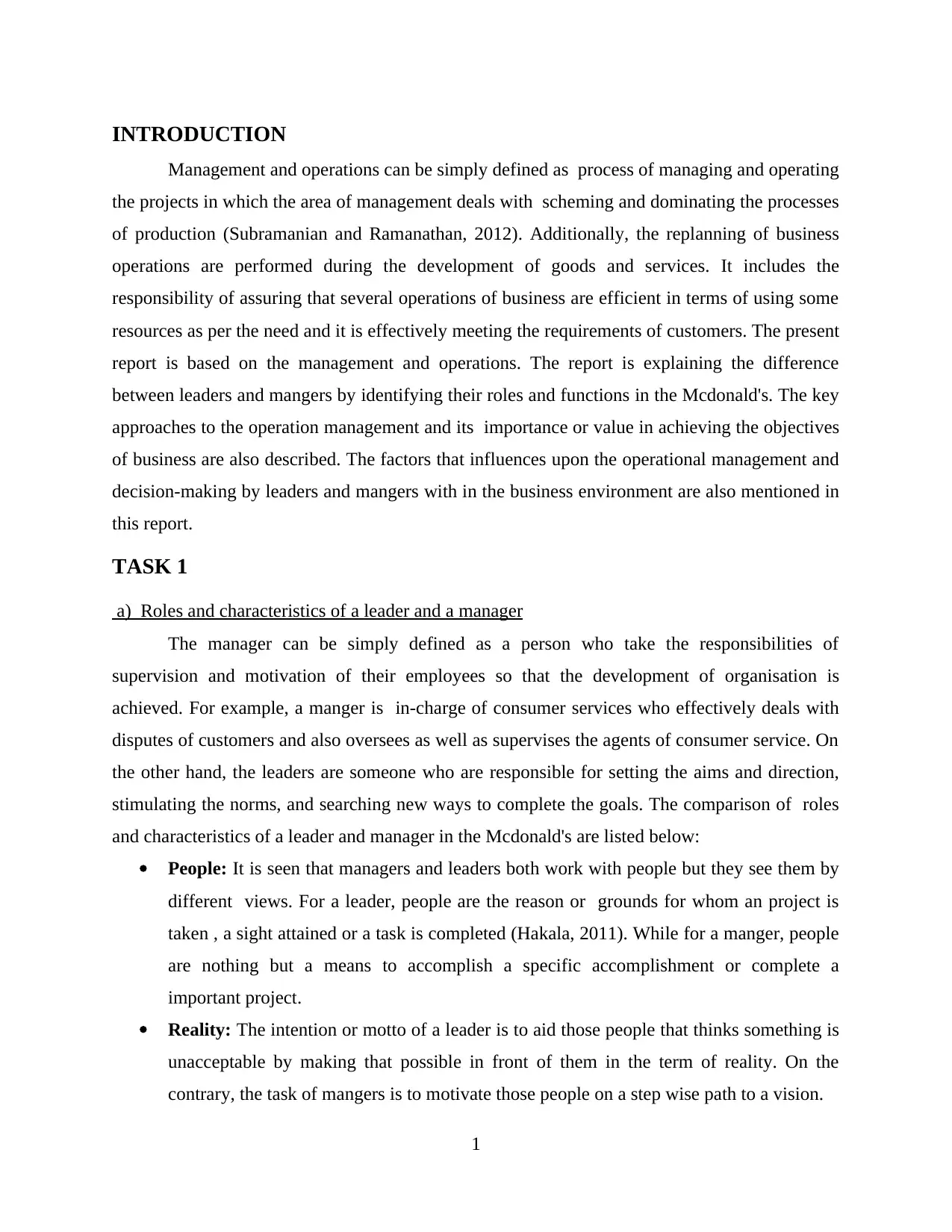
INTRODUCTION
Management and operations can be simply defined as process of managing and operating
the projects in which the area of management deals with scheming and dominating the processes
of production (Subramanian and Ramanathan, 2012). Additionally, the replanning of business
operations are performed during the development of goods and services. It includes the
responsibility of assuring that several operations of business are efficient in terms of using some
resources as per the need and it is effectively meeting the requirements of customers. The present
report is based on the management and operations. The report is explaining the difference
between leaders and mangers by identifying their roles and functions in the Mcdonald's. The key
approaches to the operation management and its importance or value in achieving the objectives
of business are also described. The factors that influences upon the operational management and
decision-making by leaders and mangers with in the business environment are also mentioned in
this report.
TASK 1
a) Roles and characteristics of a leader and a manager
The manager can be simply defined as a person who take the responsibilities of
supervision and motivation of their employees so that the development of organisation is
achieved. For example, a manger is in-charge of consumer services who effectively deals with
disputes of customers and also oversees as well as supervises the agents of consumer service. On
the other hand, the leaders are someone who are responsible for setting the aims and direction,
stimulating the norms, and searching new ways to complete the goals. The comparison of roles
and characteristics of a leader and manager in the Mcdonald's are listed below:
People: It is seen that managers and leaders both work with people but they see them by
different views. For a leader, people are the reason or grounds for whom an project is
taken , a sight attained or a task is completed (Hakala, 2011). While for a manger, people
are nothing but a means to accomplish a specific accomplishment or complete a
important project.
Reality: The intention or motto of a leader is to aid those people that thinks something is
unacceptable by making that possible in front of them in the term of reality. On the
contrary, the task of mangers is to motivate those people on a step wise path to a vision.
1
Management and operations can be simply defined as process of managing and operating
the projects in which the area of management deals with scheming and dominating the processes
of production (Subramanian and Ramanathan, 2012). Additionally, the replanning of business
operations are performed during the development of goods and services. It includes the
responsibility of assuring that several operations of business are efficient in terms of using some
resources as per the need and it is effectively meeting the requirements of customers. The present
report is based on the management and operations. The report is explaining the difference
between leaders and mangers by identifying their roles and functions in the Mcdonald's. The key
approaches to the operation management and its importance or value in achieving the objectives
of business are also described. The factors that influences upon the operational management and
decision-making by leaders and mangers with in the business environment are also mentioned in
this report.
TASK 1
a) Roles and characteristics of a leader and a manager
The manager can be simply defined as a person who take the responsibilities of
supervision and motivation of their employees so that the development of organisation is
achieved. For example, a manger is in-charge of consumer services who effectively deals with
disputes of customers and also oversees as well as supervises the agents of consumer service. On
the other hand, the leaders are someone who are responsible for setting the aims and direction,
stimulating the norms, and searching new ways to complete the goals. The comparison of roles
and characteristics of a leader and manager in the Mcdonald's are listed below:
People: It is seen that managers and leaders both work with people but they see them by
different views. For a leader, people are the reason or grounds for whom an project is
taken , a sight attained or a task is completed (Hakala, 2011). While for a manger, people
are nothing but a means to accomplish a specific accomplishment or complete a
important project.
Reality: The intention or motto of a leader is to aid those people that thinks something is
unacceptable by making that possible in front of them in the term of reality. On the
contrary, the task of mangers is to motivate those people on a step wise path to a vision.
1
Paraphrase This Document
Need a fresh take? Get an instant paraphrase of this document with our AI Paraphraser
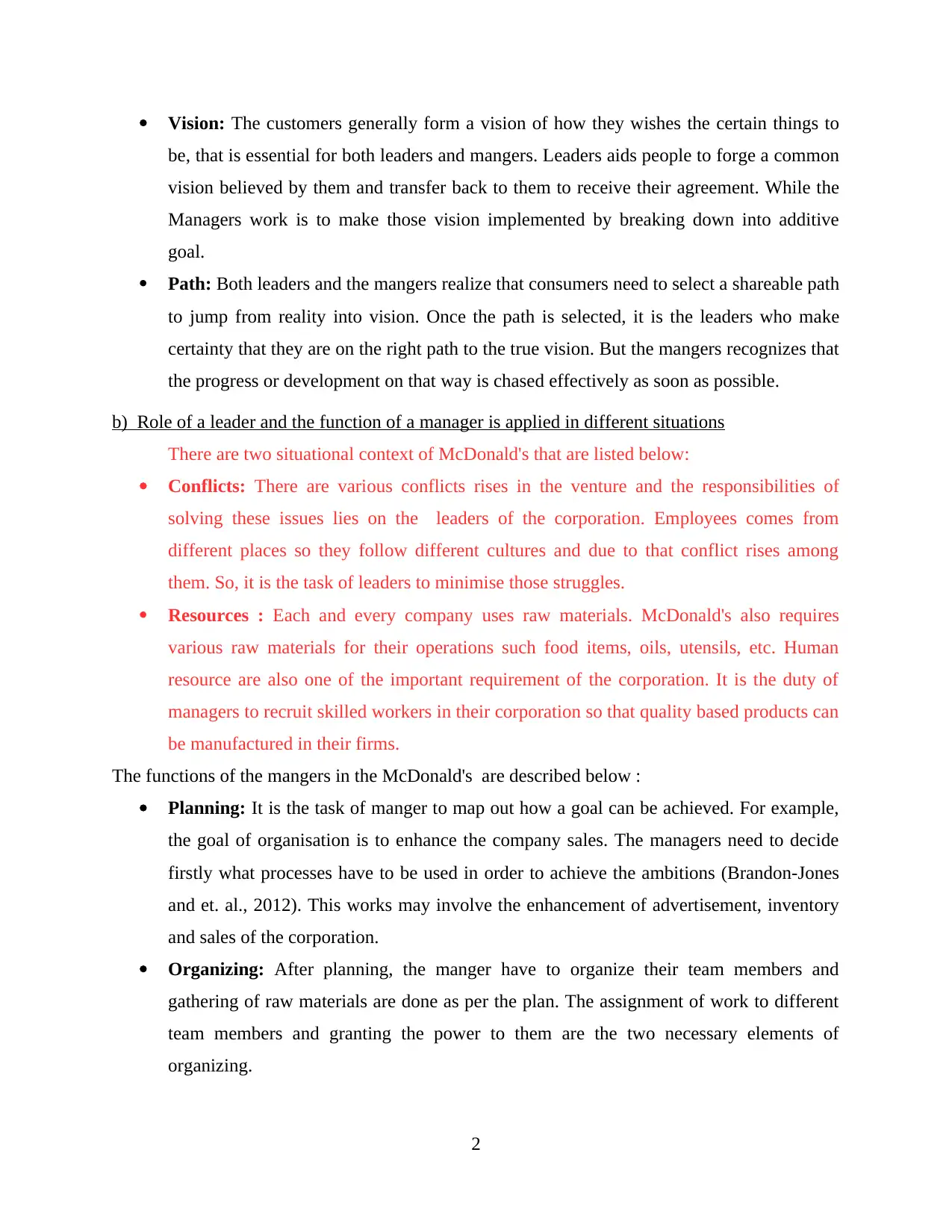
Vision: The customers generally form a vision of how they wishes the certain things to
be, that is essential for both leaders and mangers. Leaders aids people to forge a common
vision believed by them and transfer back to them to receive their agreement. While the
Managers work is to make those vision implemented by breaking down into additive
goal.
Path: Both leaders and the mangers realize that consumers need to select a shareable path
to jump from reality into vision. Once the path is selected, it is the leaders who make
certainty that they are on the right path to the true vision. But the mangers recognizes that
the progress or development on that way is chased effectively as soon as possible.
b) Role of a leader and the function of a manager is applied in different situations
There are two situational context of McDonald's that are listed below:
Conflicts: There are various conflicts rises in the venture and the responsibilities of
solving these issues lies on the leaders of the corporation. Employees comes from
different places so they follow different cultures and due to that conflict rises among
them. So, it is the task of leaders to minimise those struggles.
Resources : Each and every company uses raw materials. McDonald's also requires
various raw materials for their operations such food items, oils, utensils, etc. Human
resource are also one of the important requirement of the corporation. It is the duty of
managers to recruit skilled workers in their corporation so that quality based products can
be manufactured in their firms.
The functions of the mangers in the McDonald's are described below :
Planning: It is the task of manger to map out how a goal can be achieved. For example,
the goal of organisation is to enhance the company sales. The managers need to decide
firstly what processes have to be used in order to achieve the ambitions (Brandon-Jones
and et. al., 2012). This works may involve the enhancement of advertisement, inventory
and sales of the corporation.
Organizing: After planning, the manger have to organize their team members and
gathering of raw materials are done as per the plan. The assignment of work to different
team members and granting the power to them are the two necessary elements of
organizing.
2
be, that is essential for both leaders and mangers. Leaders aids people to forge a common
vision believed by them and transfer back to them to receive their agreement. While the
Managers work is to make those vision implemented by breaking down into additive
goal.
Path: Both leaders and the mangers realize that consumers need to select a shareable path
to jump from reality into vision. Once the path is selected, it is the leaders who make
certainty that they are on the right path to the true vision. But the mangers recognizes that
the progress or development on that way is chased effectively as soon as possible.
b) Role of a leader and the function of a manager is applied in different situations
There are two situational context of McDonald's that are listed below:
Conflicts: There are various conflicts rises in the venture and the responsibilities of
solving these issues lies on the leaders of the corporation. Employees comes from
different places so they follow different cultures and due to that conflict rises among
them. So, it is the task of leaders to minimise those struggles.
Resources : Each and every company uses raw materials. McDonald's also requires
various raw materials for their operations such food items, oils, utensils, etc. Human
resource are also one of the important requirement of the corporation. It is the duty of
managers to recruit skilled workers in their corporation so that quality based products can
be manufactured in their firms.
The functions of the mangers in the McDonald's are described below :
Planning: It is the task of manger to map out how a goal can be achieved. For example,
the goal of organisation is to enhance the company sales. The managers need to decide
firstly what processes have to be used in order to achieve the ambitions (Brandon-Jones
and et. al., 2012). This works may involve the enhancement of advertisement, inventory
and sales of the corporation.
Organizing: After planning, the manger have to organize their team members and
gathering of raw materials are done as per the plan. The assignment of work to different
team members and granting the power to them are the two necessary elements of
organizing.
2
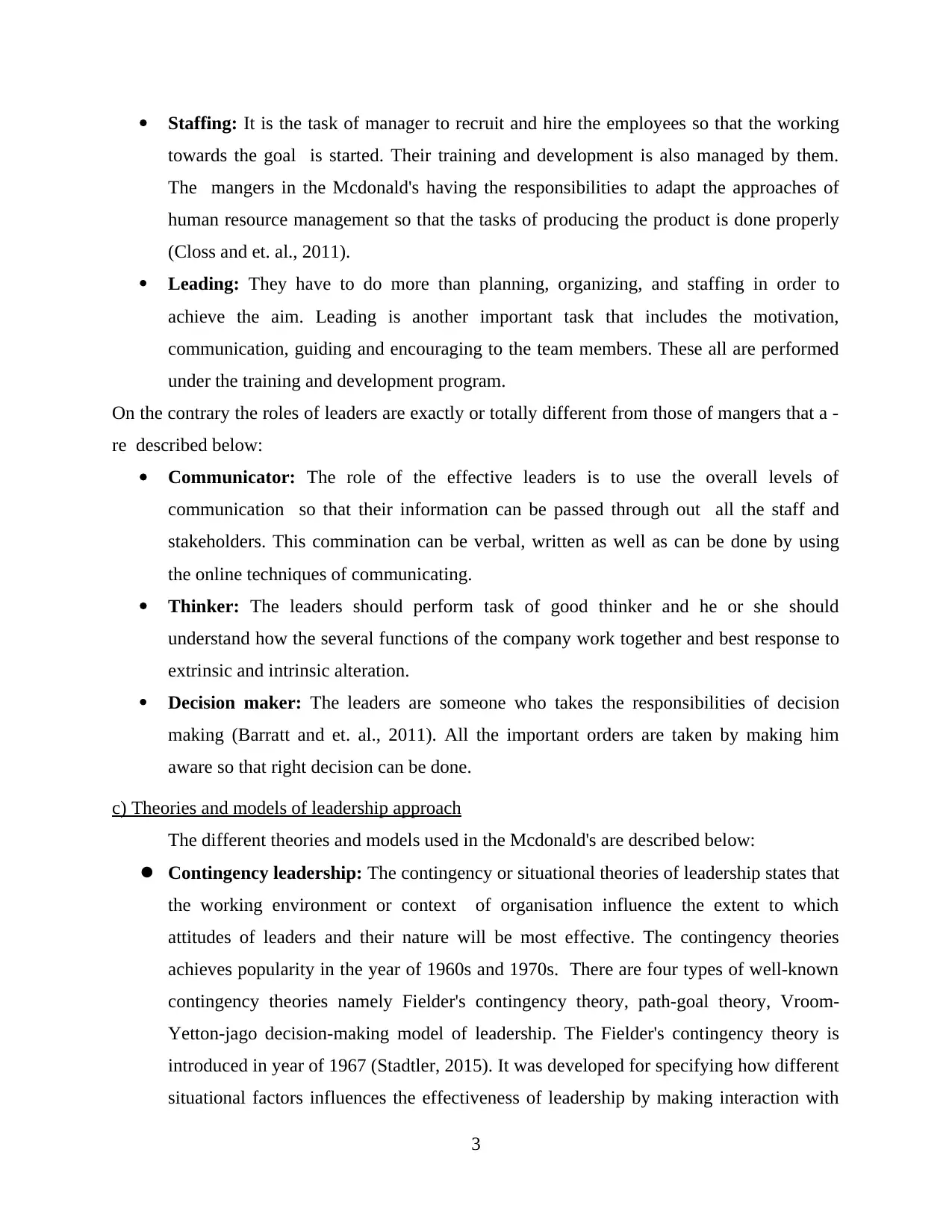
Staffing: It is the task of manager to recruit and hire the employees so that the working
towards the goal is started. Their training and development is also managed by them.
The mangers in the Mcdonald's having the responsibilities to adapt the approaches of
human resource management so that the tasks of producing the product is done properly
(Closs and et. al., 2011).
Leading: They have to do more than planning, organizing, and staffing in order to
achieve the aim. Leading is another important task that includes the motivation,
communication, guiding and encouraging to the team members. These all are performed
under the training and development program.
On the contrary the roles of leaders are exactly or totally different from those of mangers that a -
re described below:
Communicator: The role of the effective leaders is to use the overall levels of
communication so that their information can be passed through out all the staff and
stakeholders. This commination can be verbal, written as well as can be done by using
the online techniques of communicating.
Thinker: The leaders should perform task of good thinker and he or she should
understand how the several functions of the company work together and best response to
extrinsic and intrinsic alteration.
Decision maker: The leaders are someone who takes the responsibilities of decision
making (Barratt and et. al., 2011). All the important orders are taken by making him
aware so that right decision can be done.
c) Theories and models of leadership approach
The different theories and models used in the Mcdonald's are described below:
Contingency leadership: The contingency or situational theories of leadership states that
the working environment or context of organisation influence the extent to which
attitudes of leaders and their nature will be most effective. The contingency theories
achieves popularity in the year of 1960s and 1970s. There are four types of well-known
contingency theories namely Fielder's contingency theory, path-goal theory, Vroom-
Yetton-jago decision-making model of leadership. The Fielder's contingency theory is
introduced in year of 1967 (Stadtler, 2015). It was developed for specifying how different
situational factors influences the effectiveness of leadership by making interaction with
3
towards the goal is started. Their training and development is also managed by them.
The mangers in the Mcdonald's having the responsibilities to adapt the approaches of
human resource management so that the tasks of producing the product is done properly
(Closs and et. al., 2011).
Leading: They have to do more than planning, organizing, and staffing in order to
achieve the aim. Leading is another important task that includes the motivation,
communication, guiding and encouraging to the team members. These all are performed
under the training and development program.
On the contrary the roles of leaders are exactly or totally different from those of mangers that a -
re described below:
Communicator: The role of the effective leaders is to use the overall levels of
communication so that their information can be passed through out all the staff and
stakeholders. This commination can be verbal, written as well as can be done by using
the online techniques of communicating.
Thinker: The leaders should perform task of good thinker and he or she should
understand how the several functions of the company work together and best response to
extrinsic and intrinsic alteration.
Decision maker: The leaders are someone who takes the responsibilities of decision
making (Barratt and et. al., 2011). All the important orders are taken by making him
aware so that right decision can be done.
c) Theories and models of leadership approach
The different theories and models used in the Mcdonald's are described below:
Contingency leadership: The contingency or situational theories of leadership states that
the working environment or context of organisation influence the extent to which
attitudes of leaders and their nature will be most effective. The contingency theories
achieves popularity in the year of 1960s and 1970s. There are four types of well-known
contingency theories namely Fielder's contingency theory, path-goal theory, Vroom-
Yetton-jago decision-making model of leadership. The Fielder's contingency theory is
introduced in year of 1967 (Stadtler, 2015). It was developed for specifying how different
situational factors influences the effectiveness of leadership by making interaction with
3
⊘ This is a preview!⊘
Do you want full access?
Subscribe today to unlock all pages.

Trusted by 1+ million students worldwide
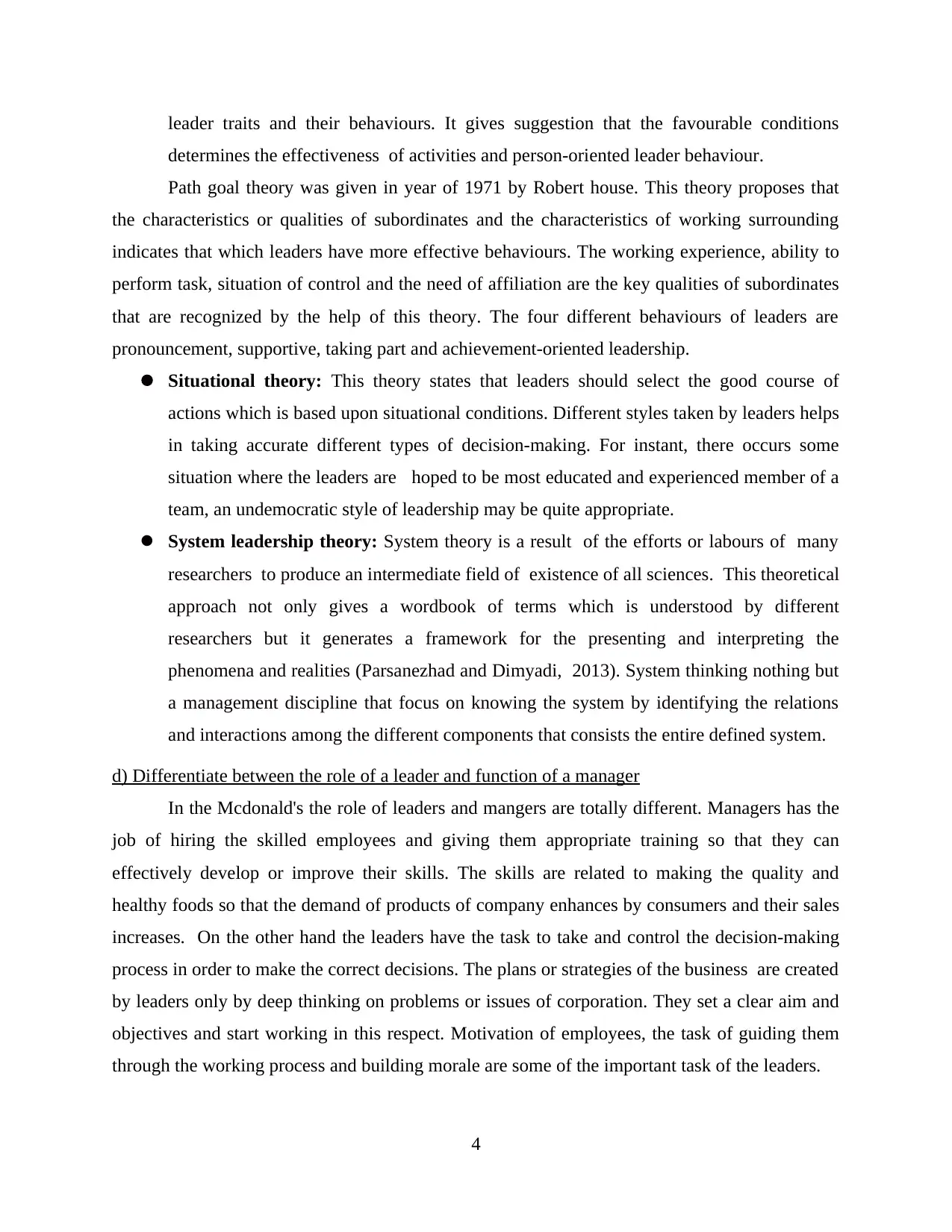
leader traits and their behaviours. It gives suggestion that the favourable conditions
determines the effectiveness of activities and person-oriented leader behaviour.
Path goal theory was given in year of 1971 by Robert house. This theory proposes that
the characteristics or qualities of subordinates and the characteristics of working surrounding
indicates that which leaders have more effective behaviours. The working experience, ability to
perform task, situation of control and the need of affiliation are the key qualities of subordinates
that are recognized by the help of this theory. The four different behaviours of leaders are
pronouncement, supportive, taking part and achievement-oriented leadership.
Situational theory: This theory states that leaders should select the good course of
actions which is based upon situational conditions. Different styles taken by leaders helps
in taking accurate different types of decision-making. For instant, there occurs some
situation where the leaders are hoped to be most educated and experienced member of a
team, an undemocratic style of leadership may be quite appropriate.
System leadership theory: System theory is a result of the efforts or labours of many
researchers to produce an intermediate field of existence of all sciences. This theoretical
approach not only gives a wordbook of terms which is understood by different
researchers but it generates a framework for the presenting and interpreting the
phenomena and realities (Parsanezhad and Dimyadi, 2013). System thinking nothing but
a management discipline that focus on knowing the system by identifying the relations
and interactions among the different components that consists the entire defined system.
d) Differentiate between the role of a leader and function of a manager
In the Mcdonald's the role of leaders and mangers are totally different. Managers has the
job of hiring the skilled employees and giving them appropriate training so that they can
effectively develop or improve their skills. The skills are related to making the quality and
healthy foods so that the demand of products of company enhances by consumers and their sales
increases. On the other hand the leaders have the task to take and control the decision-making
process in order to make the correct decisions. The plans or strategies of the business are created
by leaders only by deep thinking on problems or issues of corporation. They set a clear aim and
objectives and start working in this respect. Motivation of employees, the task of guiding them
through the working process and building morale are some of the important task of the leaders.
4
determines the effectiveness of activities and person-oriented leader behaviour.
Path goal theory was given in year of 1971 by Robert house. This theory proposes that
the characteristics or qualities of subordinates and the characteristics of working surrounding
indicates that which leaders have more effective behaviours. The working experience, ability to
perform task, situation of control and the need of affiliation are the key qualities of subordinates
that are recognized by the help of this theory. The four different behaviours of leaders are
pronouncement, supportive, taking part and achievement-oriented leadership.
Situational theory: This theory states that leaders should select the good course of
actions which is based upon situational conditions. Different styles taken by leaders helps
in taking accurate different types of decision-making. For instant, there occurs some
situation where the leaders are hoped to be most educated and experienced member of a
team, an undemocratic style of leadership may be quite appropriate.
System leadership theory: System theory is a result of the efforts or labours of many
researchers to produce an intermediate field of existence of all sciences. This theoretical
approach not only gives a wordbook of terms which is understood by different
researchers but it generates a framework for the presenting and interpreting the
phenomena and realities (Parsanezhad and Dimyadi, 2013). System thinking nothing but
a management discipline that focus on knowing the system by identifying the relations
and interactions among the different components that consists the entire defined system.
d) Differentiate between the role of a leader and function of a manager
In the Mcdonald's the role of leaders and mangers are totally different. Managers has the
job of hiring the skilled employees and giving them appropriate training so that they can
effectively develop or improve their skills. The skills are related to making the quality and
healthy foods so that the demand of products of company enhances by consumers and their sales
increases. On the other hand the leaders have the task to take and control the decision-making
process in order to make the correct decisions. The plans or strategies of the business are created
by leaders only by deep thinking on problems or issues of corporation. They set a clear aim and
objectives and start working in this respect. Motivation of employees, the task of guiding them
through the working process and building morale are some of the important task of the leaders.
4
Paraphrase This Document
Need a fresh take? Get an instant paraphrase of this document with our AI Paraphraser
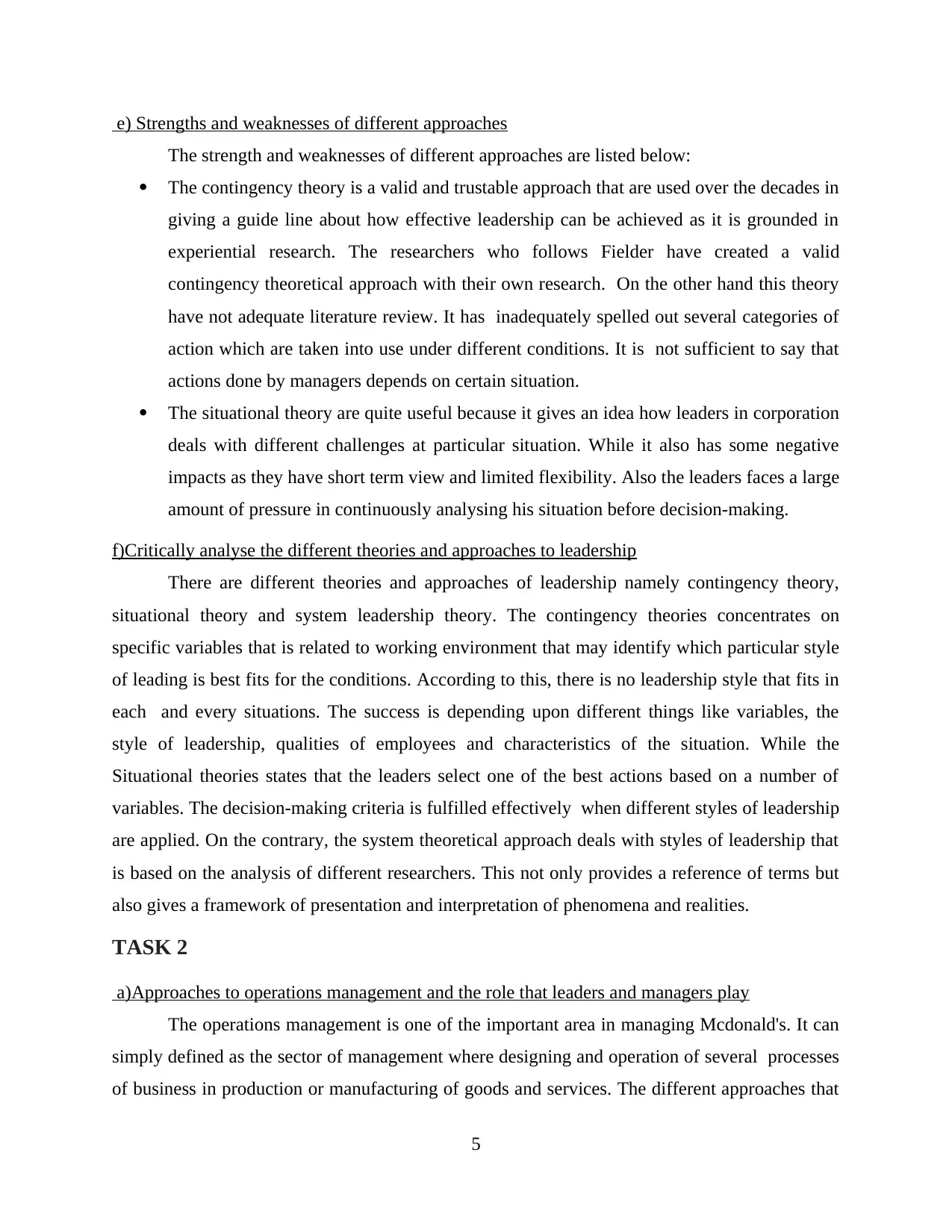
e) Strengths and weaknesses of different approaches
The strength and weaknesses of different approaches are listed below:
The contingency theory is a valid and trustable approach that are used over the decades in
giving a guide line about how effective leadership can be achieved as it is grounded in
experiential research. The researchers who follows Fielder have created a valid
contingency theoretical approach with their own research. On the other hand this theory
have not adequate literature review. It has inadequately spelled out several categories of
action which are taken into use under different conditions. It is not sufficient to say that
actions done by managers depends on certain situation.
The situational theory are quite useful because it gives an idea how leaders in corporation
deals with different challenges at particular situation. While it also has some negative
impacts as they have short term view and limited flexibility. Also the leaders faces a large
amount of pressure in continuously analysing his situation before decision-making.
f)Critically analyse the different theories and approaches to leadership
There are different theories and approaches of leadership namely contingency theory,
situational theory and system leadership theory. The contingency theories concentrates on
specific variables that is related to working environment that may identify which particular style
of leading is best fits for the conditions. According to this, there is no leadership style that fits in
each and every situations. The success is depending upon different things like variables, the
style of leadership, qualities of employees and characteristics of the situation. While the
Situational theories states that the leaders select one of the best actions based on a number of
variables. The decision-making criteria is fulfilled effectively when different styles of leadership
are applied. On the contrary, the system theoretical approach deals with styles of leadership that
is based on the analysis of different researchers. This not only provides a reference of terms but
also gives a framework of presentation and interpretation of phenomena and realities.
TASK 2
a)Approaches to operations management and the role that leaders and managers play
The operations management is one of the important area in managing Mcdonald's. It can
simply defined as the sector of management where designing and operation of several processes
of business in production or manufacturing of goods and services. The different approaches that
5
The strength and weaknesses of different approaches are listed below:
The contingency theory is a valid and trustable approach that are used over the decades in
giving a guide line about how effective leadership can be achieved as it is grounded in
experiential research. The researchers who follows Fielder have created a valid
contingency theoretical approach with their own research. On the other hand this theory
have not adequate literature review. It has inadequately spelled out several categories of
action which are taken into use under different conditions. It is not sufficient to say that
actions done by managers depends on certain situation.
The situational theory are quite useful because it gives an idea how leaders in corporation
deals with different challenges at particular situation. While it also has some negative
impacts as they have short term view and limited flexibility. Also the leaders faces a large
amount of pressure in continuously analysing his situation before decision-making.
f)Critically analyse the different theories and approaches to leadership
There are different theories and approaches of leadership namely contingency theory,
situational theory and system leadership theory. The contingency theories concentrates on
specific variables that is related to working environment that may identify which particular style
of leading is best fits for the conditions. According to this, there is no leadership style that fits in
each and every situations. The success is depending upon different things like variables, the
style of leadership, qualities of employees and characteristics of the situation. While the
Situational theories states that the leaders select one of the best actions based on a number of
variables. The decision-making criteria is fulfilled effectively when different styles of leadership
are applied. On the contrary, the system theoretical approach deals with styles of leadership that
is based on the analysis of different researchers. This not only provides a reference of terms but
also gives a framework of presentation and interpretation of phenomena and realities.
TASK 2
a)Approaches to operations management and the role that leaders and managers play
The operations management is one of the important area in managing Mcdonald's. It can
simply defined as the sector of management where designing and operation of several processes
of business in production or manufacturing of goods and services. The different approaches that
5
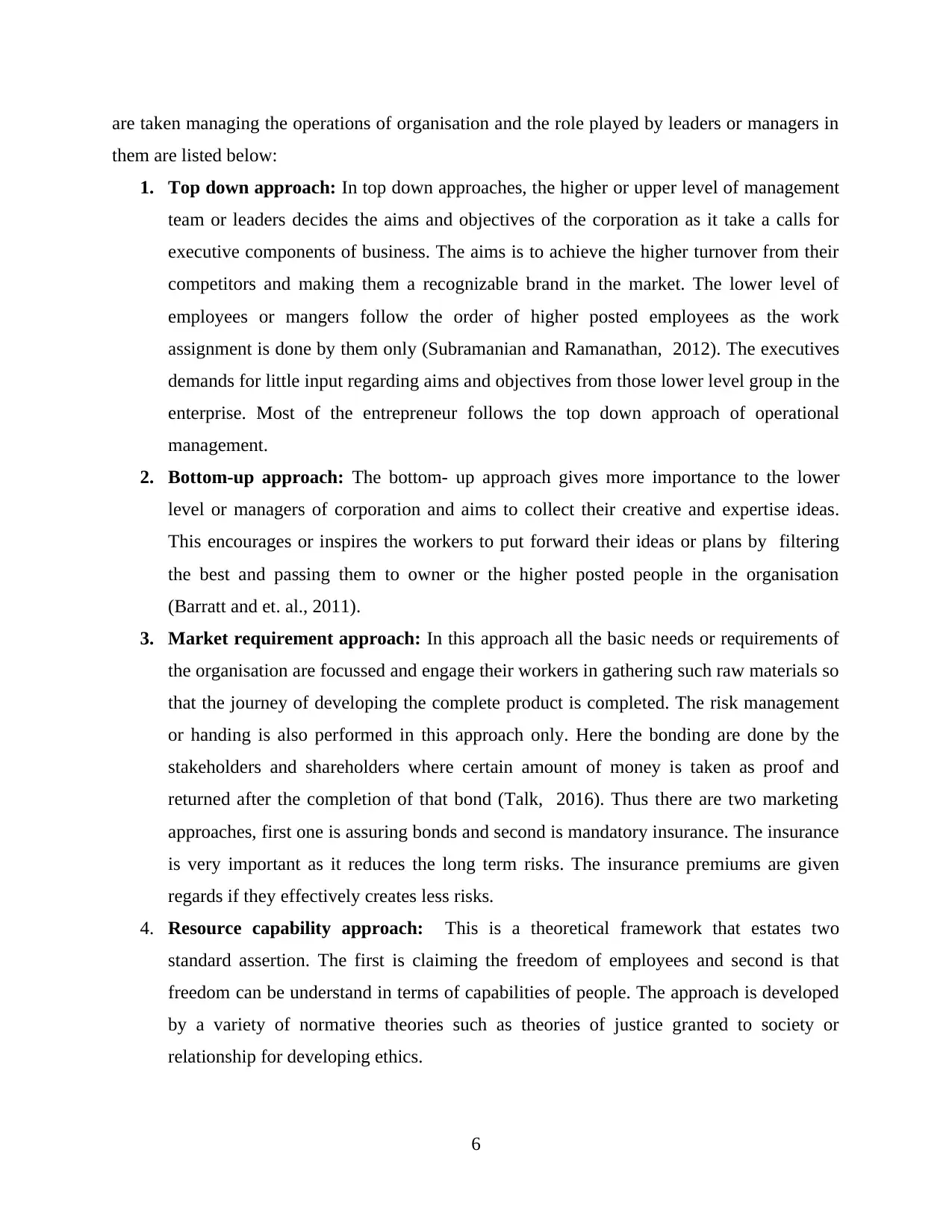
are taken managing the operations of organisation and the role played by leaders or managers in
them are listed below:
1. Top down approach: In top down approaches, the higher or upper level of management
team or leaders decides the aims and objectives of the corporation as it take a calls for
executive components of business. The aims is to achieve the higher turnover from their
competitors and making them a recognizable brand in the market. The lower level of
employees or mangers follow the order of higher posted employees as the work
assignment is done by them only (Subramanian and Ramanathan, 2012). The executives
demands for little input regarding aims and objectives from those lower level group in the
enterprise. Most of the entrepreneur follows the top down approach of operational
management.
2. Bottom-up approach: The bottom- up approach gives more importance to the lower
level or managers of corporation and aims to collect their creative and expertise ideas.
This encourages or inspires the workers to put forward their ideas or plans by filtering
the best and passing them to owner or the higher posted people in the organisation
(Barratt and et. al., 2011).
3. Market requirement approach: In this approach all the basic needs or requirements of
the organisation are focussed and engage their workers in gathering such raw materials so
that the journey of developing the complete product is completed. The risk management
or handing is also performed in this approach only. Here the bonding are done by the
stakeholders and shareholders where certain amount of money is taken as proof and
returned after the completion of that bond (Talk, 2016). Thus there are two marketing
approaches, first one is assuring bonds and second is mandatory insurance. The insurance
is very important as it reduces the long term risks. The insurance premiums are given
regards if they effectively creates less risks.
4. Resource capability approach: This is a theoretical framework that estates two
standard assertion. The first is claiming the freedom of employees and second is that
freedom can be understand in terms of capabilities of people. The approach is developed
by a variety of normative theories such as theories of justice granted to society or
relationship for developing ethics.
6
them are listed below:
1. Top down approach: In top down approaches, the higher or upper level of management
team or leaders decides the aims and objectives of the corporation as it take a calls for
executive components of business. The aims is to achieve the higher turnover from their
competitors and making them a recognizable brand in the market. The lower level of
employees or mangers follow the order of higher posted employees as the work
assignment is done by them only (Subramanian and Ramanathan, 2012). The executives
demands for little input regarding aims and objectives from those lower level group in the
enterprise. Most of the entrepreneur follows the top down approach of operational
management.
2. Bottom-up approach: The bottom- up approach gives more importance to the lower
level or managers of corporation and aims to collect their creative and expertise ideas.
This encourages or inspires the workers to put forward their ideas or plans by filtering
the best and passing them to owner or the higher posted people in the organisation
(Barratt and et. al., 2011).
3. Market requirement approach: In this approach all the basic needs or requirements of
the organisation are focussed and engage their workers in gathering such raw materials so
that the journey of developing the complete product is completed. The risk management
or handing is also performed in this approach only. Here the bonding are done by the
stakeholders and shareholders where certain amount of money is taken as proof and
returned after the completion of that bond (Talk, 2016). Thus there are two marketing
approaches, first one is assuring bonds and second is mandatory insurance. The insurance
is very important as it reduces the long term risks. The insurance premiums are given
regards if they effectively creates less risks.
4. Resource capability approach: This is a theoretical framework that estates two
standard assertion. The first is claiming the freedom of employees and second is that
freedom can be understand in terms of capabilities of people. The approach is developed
by a variety of normative theories such as theories of justice granted to society or
relationship for developing ethics.
6
⊘ This is a preview!⊘
Do you want full access?
Subscribe today to unlock all pages.

Trusted by 1+ million students worldwide
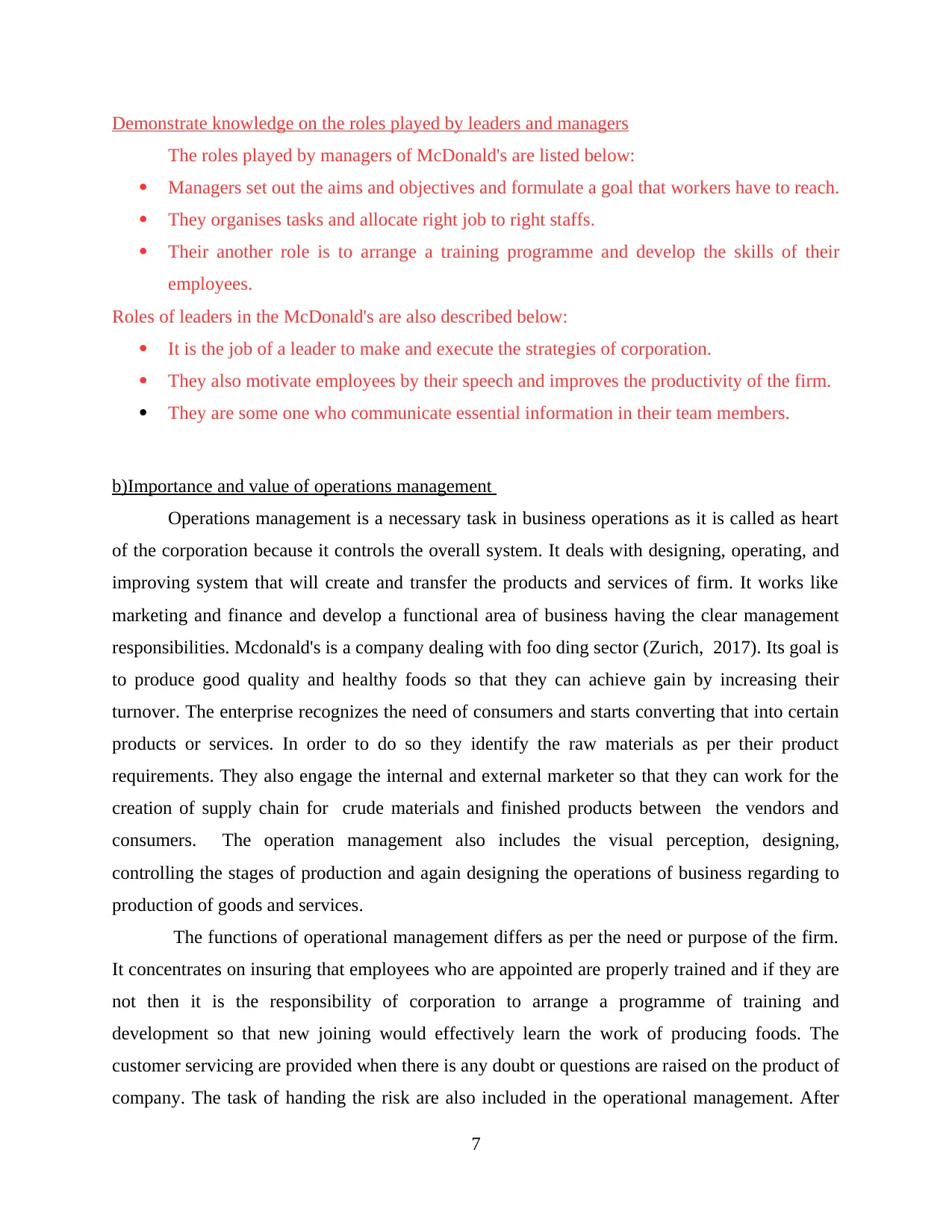
Demonstrate knowledge on the roles played by leaders and managers
The roles played by managers of McDonald's are listed below:
Managers set out the aims and objectives and formulate a goal that workers have to reach.
They organises tasks and allocate right job to right staffs.
Their another role is to arrange a training programme and develop the skills of their
employees.
Roles of leaders in the McDonald's are also described below:
It is the job of a leader to make and execute the strategies of corporation.
They also motivate employees by their speech and improves the productivity of the firm.
They are some one who communicate essential information in their team members.
b)Importance and value of operations management
Operations management is a necessary task in business operations as it is called as heart
of the corporation because it controls the overall system. It deals with designing, operating, and
improving system that will create and transfer the products and services of firm. It works like
marketing and finance and develop a functional area of business having the clear management
responsibilities. Mcdonald's is a company dealing with foo ding sector (Zurich, 2017). Its goal is
to produce good quality and healthy foods so that they can achieve gain by increasing their
turnover. The enterprise recognizes the need of consumers and starts converting that into certain
products or services. In order to do so they identify the raw materials as per their product
requirements. They also engage the internal and external marketer so that they can work for the
creation of supply chain for crude materials and finished products between the vendors and
consumers. The operation management also includes the visual perception, designing,
controlling the stages of production and again designing the operations of business regarding to
production of goods and services.
The functions of operational management differs as per the need or purpose of the firm.
It concentrates on insuring that employees who are appointed are properly trained and if they are
not then it is the responsibility of corporation to arrange a programme of training and
development so that new joining would effectively learn the work of producing foods. The
customer servicing are provided when there is any doubt or questions are raised on the product of
company. The task of handing the risk are also included in the operational management. After
7
The roles played by managers of McDonald's are listed below:
Managers set out the aims and objectives and formulate a goal that workers have to reach.
They organises tasks and allocate right job to right staffs.
Their another role is to arrange a training programme and develop the skills of their
employees.
Roles of leaders in the McDonald's are also described below:
It is the job of a leader to make and execute the strategies of corporation.
They also motivate employees by their speech and improves the productivity of the firm.
They are some one who communicate essential information in their team members.
b)Importance and value of operations management
Operations management is a necessary task in business operations as it is called as heart
of the corporation because it controls the overall system. It deals with designing, operating, and
improving system that will create and transfer the products and services of firm. It works like
marketing and finance and develop a functional area of business having the clear management
responsibilities. Mcdonald's is a company dealing with foo ding sector (Zurich, 2017). Its goal is
to produce good quality and healthy foods so that they can achieve gain by increasing their
turnover. The enterprise recognizes the need of consumers and starts converting that into certain
products or services. In order to do so they identify the raw materials as per their product
requirements. They also engage the internal and external marketer so that they can work for the
creation of supply chain for crude materials and finished products between the vendors and
consumers. The operation management also includes the visual perception, designing,
controlling the stages of production and again designing the operations of business regarding to
production of goods and services.
The functions of operational management differs as per the need or purpose of the firm.
It concentrates on insuring that employees who are appointed are properly trained and if they are
not then it is the responsibility of corporation to arrange a programme of training and
development so that new joining would effectively learn the work of producing foods. The
customer servicing are provided when there is any doubt or questions are raised on the product of
company. The task of handing the risk are also included in the operational management. After
7
Paraphrase This Document
Need a fresh take? Get an instant paraphrase of this document with our AI Paraphraser
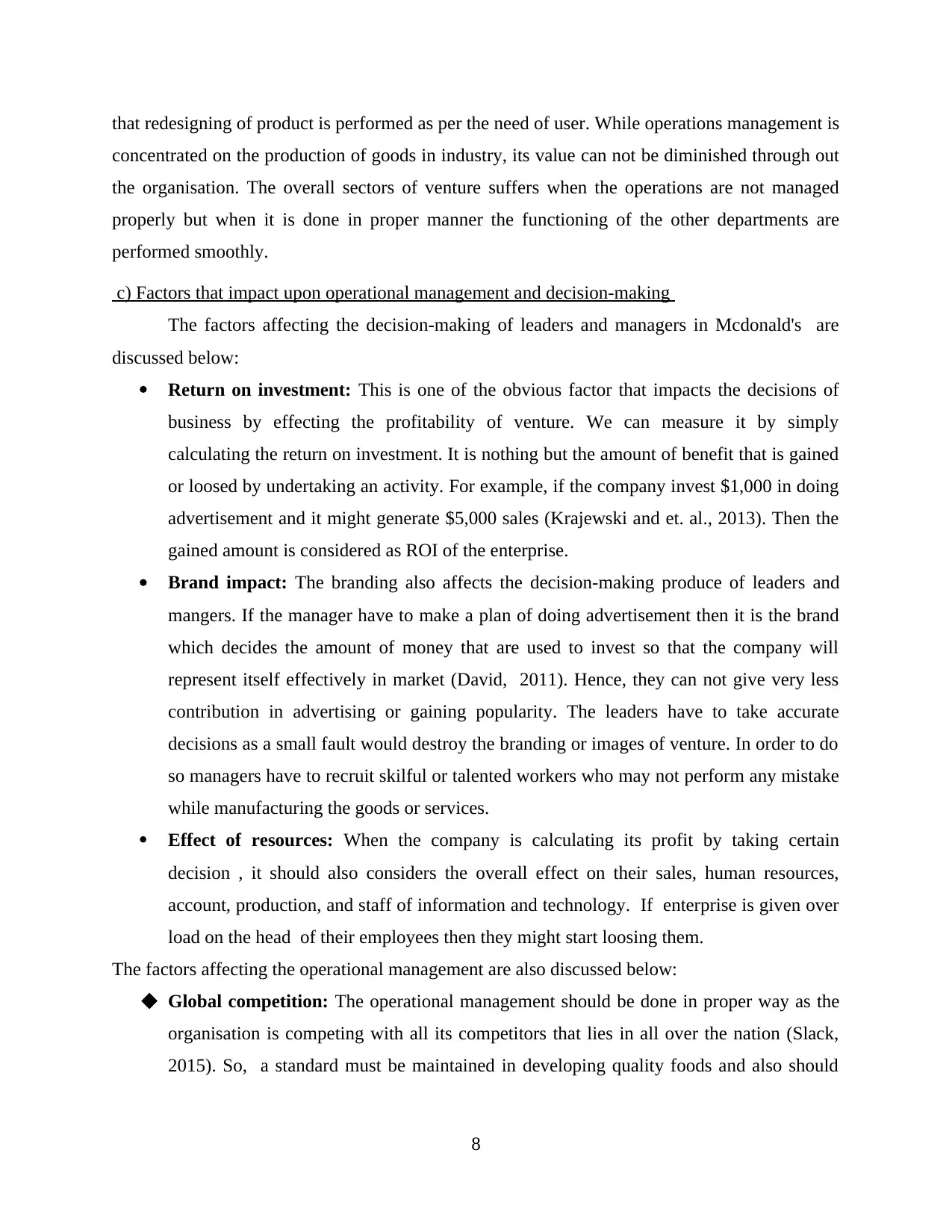
that redesigning of product is performed as per the need of user. While operations management is
concentrated on the production of goods in industry, its value can not be diminished through out
the organisation. The overall sectors of venture suffers when the operations are not managed
properly but when it is done in proper manner the functioning of the other departments are
performed smoothly.
c) Factors that impact upon operational management and decision-making
The factors affecting the decision-making of leaders and managers in Mcdonald's are
discussed below:
Return on investment: This is one of the obvious factor that impacts the decisions of
business by effecting the profitability of venture. We can measure it by simply
calculating the return on investment. It is nothing but the amount of benefit that is gained
or loosed by undertaking an activity. For example, if the company invest $1,000 in doing
advertisement and it might generate $5,000 sales (Krajewski and et. al., 2013). Then the
gained amount is considered as ROI of the enterprise.
Brand impact: The branding also affects the decision-making produce of leaders and
mangers. If the manager have to make a plan of doing advertisement then it is the brand
which decides the amount of money that are used to invest so that the company will
represent itself effectively in market (David, 2011). Hence, they can not give very less
contribution in advertising or gaining popularity. The leaders have to take accurate
decisions as a small fault would destroy the branding or images of venture. In order to do
so managers have to recruit skilful or talented workers who may not perform any mistake
while manufacturing the goods or services.
Effect of resources: When the company is calculating its profit by taking certain
decision , it should also considers the overall effect on their sales, human resources,
account, production, and staff of information and technology. If enterprise is given over
load on the head of their employees then they might start loosing them.
The factors affecting the operational management are also discussed below:
Global competition: The operational management should be done in proper way as the
organisation is competing with all its competitors that lies in all over the nation (Slack,
2015). So, a standard must be maintained in developing quality foods and also should
8
concentrated on the production of goods in industry, its value can not be diminished through out
the organisation. The overall sectors of venture suffers when the operations are not managed
properly but when it is done in proper manner the functioning of the other departments are
performed smoothly.
c) Factors that impact upon operational management and decision-making
The factors affecting the decision-making of leaders and managers in Mcdonald's are
discussed below:
Return on investment: This is one of the obvious factor that impacts the decisions of
business by effecting the profitability of venture. We can measure it by simply
calculating the return on investment. It is nothing but the amount of benefit that is gained
or loosed by undertaking an activity. For example, if the company invest $1,000 in doing
advertisement and it might generate $5,000 sales (Krajewski and et. al., 2013). Then the
gained amount is considered as ROI of the enterprise.
Brand impact: The branding also affects the decision-making produce of leaders and
mangers. If the manager have to make a plan of doing advertisement then it is the brand
which decides the amount of money that are used to invest so that the company will
represent itself effectively in market (David, 2011). Hence, they can not give very less
contribution in advertising or gaining popularity. The leaders have to take accurate
decisions as a small fault would destroy the branding or images of venture. In order to do
so managers have to recruit skilful or talented workers who may not perform any mistake
while manufacturing the goods or services.
Effect of resources: When the company is calculating its profit by taking certain
decision , it should also considers the overall effect on their sales, human resources,
account, production, and staff of information and technology. If enterprise is given over
load on the head of their employees then they might start loosing them.
The factors affecting the operational management are also discussed below:
Global competition: The operational management should be done in proper way as the
organisation is competing with all its competitors that lies in all over the nation (Slack,
2015). So, a standard must be maintained in developing quality foods and also should
8
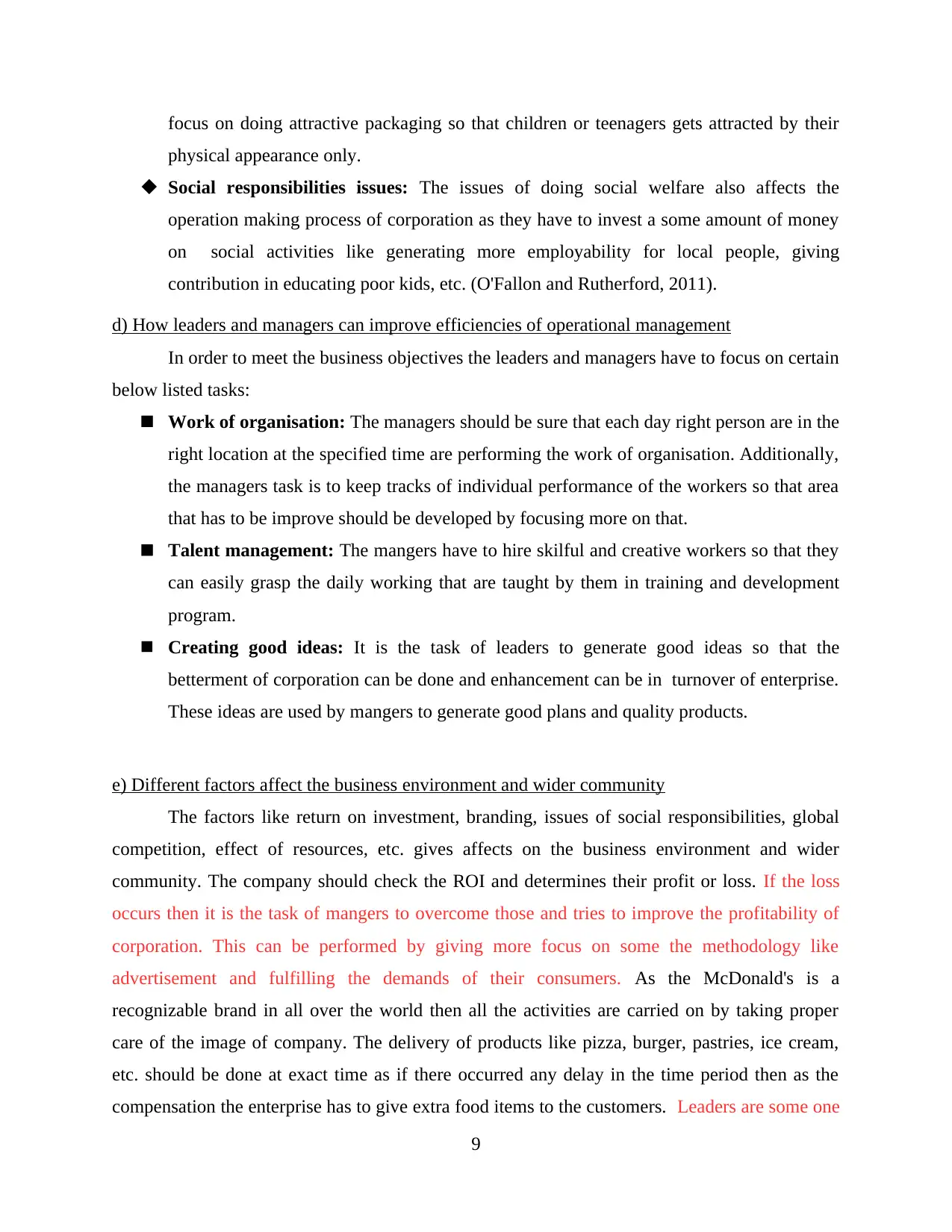
focus on doing attractive packaging so that children or teenagers gets attracted by their
physical appearance only.
Social responsibilities issues: The issues of doing social welfare also affects the
operation making process of corporation as they have to invest a some amount of money
on social activities like generating more employability for local people, giving
contribution in educating poor kids, etc. (O'Fallon and Rutherford, 2011).
d) How leaders and managers can improve efficiencies of operational management
In order to meet the business objectives the leaders and managers have to focus on certain
below listed tasks:
Work of organisation: The managers should be sure that each day right person are in the
right location at the specified time are performing the work of organisation. Additionally,
the managers task is to keep tracks of individual performance of the workers so that area
that has to be improve should be developed by focusing more on that.
Talent management: The mangers have to hire skilful and creative workers so that they
can easily grasp the daily working that are taught by them in training and development
program.
Creating good ideas: It is the task of leaders to generate good ideas so that the
betterment of corporation can be done and enhancement can be in turnover of enterprise.
These ideas are used by mangers to generate good plans and quality products.
e) Different factors affect the business environment and wider community
The factors like return on investment, branding, issues of social responsibilities, global
competition, effect of resources, etc. gives affects on the business environment and wider
community. The company should check the ROI and determines their profit or loss. If the loss
occurs then it is the task of mangers to overcome those and tries to improve the profitability of
corporation. This can be performed by giving more focus on some the methodology like
advertisement and fulfilling the demands of their consumers. As the McDonald's is a
recognizable brand in all over the world then all the activities are carried on by taking proper
care of the image of company. The delivery of products like pizza, burger, pastries, ice cream,
etc. should be done at exact time as if there occurred any delay in the time period then as the
compensation the enterprise has to give extra food items to the customers. Leaders are some one
9
physical appearance only.
Social responsibilities issues: The issues of doing social welfare also affects the
operation making process of corporation as they have to invest a some amount of money
on social activities like generating more employability for local people, giving
contribution in educating poor kids, etc. (O'Fallon and Rutherford, 2011).
d) How leaders and managers can improve efficiencies of operational management
In order to meet the business objectives the leaders and managers have to focus on certain
below listed tasks:
Work of organisation: The managers should be sure that each day right person are in the
right location at the specified time are performing the work of organisation. Additionally,
the managers task is to keep tracks of individual performance of the workers so that area
that has to be improve should be developed by focusing more on that.
Talent management: The mangers have to hire skilful and creative workers so that they
can easily grasp the daily working that are taught by them in training and development
program.
Creating good ideas: It is the task of leaders to generate good ideas so that the
betterment of corporation can be done and enhancement can be in turnover of enterprise.
These ideas are used by mangers to generate good plans and quality products.
e) Different factors affect the business environment and wider community
The factors like return on investment, branding, issues of social responsibilities, global
competition, effect of resources, etc. gives affects on the business environment and wider
community. The company should check the ROI and determines their profit or loss. If the loss
occurs then it is the task of mangers to overcome those and tries to improve the profitability of
corporation. This can be performed by giving more focus on some the methodology like
advertisement and fulfilling the demands of their consumers. As the McDonald's is a
recognizable brand in all over the world then all the activities are carried on by taking proper
care of the image of company. The delivery of products like pizza, burger, pastries, ice cream,
etc. should be done at exact time as if there occurred any delay in the time period then as the
compensation the enterprise has to give extra food items to the customers. Leaders are some one
9
⊘ This is a preview!⊘
Do you want full access?
Subscribe today to unlock all pages.

Trusted by 1+ million students worldwide
1 out of 15
Related Documents
Your All-in-One AI-Powered Toolkit for Academic Success.
+13062052269
info@desklib.com
Available 24*7 on WhatsApp / Email
![[object Object]](/_next/static/media/star-bottom.7253800d.svg)
Unlock your academic potential
Copyright © 2020–2025 A2Z Services. All Rights Reserved. Developed and managed by ZUCOL.





